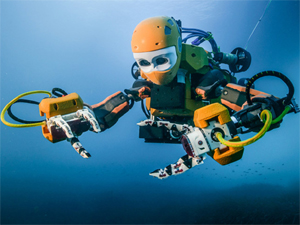



Date:29/04/16
 U.S.-based Stanford University’s robotic diver, OceanOne, has made its maiden voyage to recover treasure from King Louis XIV's wrecked flagship.
U.S.-based Stanford University’s robotic diver, OceanOne, has made its maiden voyage to recover treasure from King Louis XIV's wrecked flagship.
The robot is powered by artificial intelligence and haptic feedback systems, allowing human pilots an unprecedented ability to explore the depths of the oceans in high fidelity.
Every aspect of the robot’s design is meant to allow it to take on tasks that are either dangerous – deep-water mining, oil-rig maintenance or underwater disaster situations like the Fukushima Daiichi power plant – or simply beyond the physical limits of human divers.
The wreck of La Lune is situated in Mediterranean waters 100 meters deep. The vessel sank in 1664, 20 miles off the southern coast of France, and no human had touched the ruins – or the countless treasures and artifacts the ship once carried – in the centuries since.
With guidance from a team of deep-sea archaeologists who had studied the site, Dr Oussama Khatib, a professor of computer science at Stanford, has sat in a boat, using a set of joysticks to control OceanOne at the wreck site.
The concept for OceanOne was born from the need to study coral reefs deep in the Red Sea, far below the comfortable range of human divers. No existing robotic submarine can dive with the skill and care of a human diver, so OceanOne was conceived and built from the ground up, a successful marriage of robotics, artificial intelligence and haptic feedback systems.
OceanOne is roughly five feet long from end to end, its torso features a head with stereoscopic vision that shows the pilot exactly what the robot sees, and two fully articulated arms. The “tail” section houses batteries, computers and eight multi-directional thrusters.
Each fully articulated wrist is fitted with force sensors that relay haptic feedback to the pilot’s controls, so the human can feel whether the robot is grasping something firm and heavy, or light and delicate. (Eventually, each finger will be covered with tactile sensors.) The ‘bot’s brain also reads the data and makes sure that its hands keep a firm grip on objects, but that they don’t damage things by squeezing too tightly.
In addition to exploring shipwrecks, this makes it adept at manipulating delicate coral reef research and precisely placing underwater sensors.
Humanoid robotic diver recovers treasures from King Louis XIV's wrecked flagship
 U.S.-based Stanford University’s robotic diver, OceanOne, has made its maiden voyage to recover treasure from King Louis XIV's wrecked flagship.
U.S.-based Stanford University’s robotic diver, OceanOne, has made its maiden voyage to recover treasure from King Louis XIV's wrecked flagship.The robot is powered by artificial intelligence and haptic feedback systems, allowing human pilots an unprecedented ability to explore the depths of the oceans in high fidelity.
Every aspect of the robot’s design is meant to allow it to take on tasks that are either dangerous – deep-water mining, oil-rig maintenance or underwater disaster situations like the Fukushima Daiichi power plant – or simply beyond the physical limits of human divers.
The wreck of La Lune is situated in Mediterranean waters 100 meters deep. The vessel sank in 1664, 20 miles off the southern coast of France, and no human had touched the ruins – or the countless treasures and artifacts the ship once carried – in the centuries since.
With guidance from a team of deep-sea archaeologists who had studied the site, Dr Oussama Khatib, a professor of computer science at Stanford, has sat in a boat, using a set of joysticks to control OceanOne at the wreck site.
The concept for OceanOne was born from the need to study coral reefs deep in the Red Sea, far below the comfortable range of human divers. No existing robotic submarine can dive with the skill and care of a human diver, so OceanOne was conceived and built from the ground up, a successful marriage of robotics, artificial intelligence and haptic feedback systems.
OceanOne is roughly five feet long from end to end, its torso features a head with stereoscopic vision that shows the pilot exactly what the robot sees, and two fully articulated arms. The “tail” section houses batteries, computers and eight multi-directional thrusters.
Each fully articulated wrist is fitted with force sensors that relay haptic feedback to the pilot’s controls, so the human can feel whether the robot is grasping something firm and heavy, or light and delicate. (Eventually, each finger will be covered with tactile sensors.) The ‘bot’s brain also reads the data and makes sure that its hands keep a firm grip on objects, but that they don’t damage things by squeezing too tightly.
In addition to exploring shipwrecks, this makes it adept at manipulating delicate coral reef research and precisely placing underwater sensors.
Views: 612
©ictnews.az. All rights reserved.Similar news
- Azerbaijani project to monitor disease via mobile phones
- Innovative educational system to be improved under presidential decree
- NTRC prolongs license of two TV and radio organizations for 6 years
- Azerbaijan establishes e-registry for medicines
- Azerbaijani museum introduces e-guide
- Nar Mobile opens “Nar Dunyasi” sales and service center in Siyazan city
- International conference on custom electronic services held in Baku
- OIC secretary general to attend COMSTECH meeting in Baku
- Azerbaijan develops earthquake warning system
- New law to regulate transition to digital broadcasting in Azerbaijan
- Azerbaijani State Social Protection Fund introduces electronic digital signature
- Intellectual traffic management system in Baku to be commissioned in December
- Tax Ministry of Azerbaijan started receiving video-addresses
- World Bank recommends Azerbaijan to speed up e-service introduction in real estate
- Azerbaijan to shift to electronic registration of real estate





















